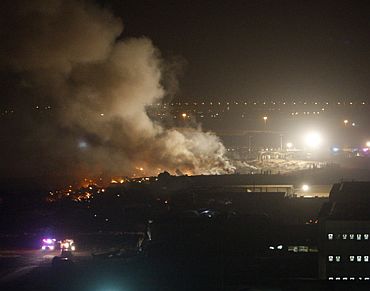 | « Back to article | Print this article |
It took Al Qaeda just $4200 to break US barriers
Terror outfit Al Qaeda in the Arabian Peninsula, which claimed responsibility for the failed attempts to send two parcel bombs to Chicago by courier planes of the FedExpress and the UPS on October 29, has come out with a detailed account of its operation code named Operation Haemorrhage in its online magazine titled Inspire.
The article, giving the detailed account, was noticed on November 20 by some US organisations that closely monitor the propaganda of the Al Qaeda and its affiliates. The New York Times has carried details of the Inspire account in its November 20 issue.
According to the Inspire article as quoted by the NYT, "The operation that cost only $4,200 (About Rs 2 lakh) to mount was intended to disrupt global air cargo systems and reflected a new strategy of low-cost attacks designed to inflict broad economic damage."
The AQAP's online magazine said it had adopted a "strategy of a thousand cuts".
It explained this strategy in the following words: "To bring down America we do not need to strike big. In such an environment of security phobia that is sweeping America, it is more feasible to stage smaller attacks that involve less players and less time to launch and thus we may circumvent the security barriers America worked so hard to erect."
Click on NEXT to read further...
The strategy of a thousand cuts
The magazine repeated an earlier claim of the AQAP that it was also responsible for the September 3 crash of a UPS plane in Dubai that killed the two pilots.
While this claim has not so far been proved due to lack of evidence that the September 3 crash was due to an explosive device, its claims of having hoodwinked the security authorities at the point of dispatch in Yemen of the two parcel bombs by successfully booking them without the explosive devices concealed in printer cartridges being detected stand proved by the details given in the Inspire article.
The strategy of a thousand cuts adopted by the AQAP against the US is reminiscent of a similar strategy used by Pakistan's Inter-Services Intelligence against India.
The objectives of the ISI's strategy are to discredit the Indian security agencies in the eyes of the Indian public, cause demoralisation, damage the Indian economy and drive a wedge between the Muslims and non-Muslims in India.
Osama's past strategy: 'Bleed until bankruptcy'
The objectives of the AQAP are to create a fear psychosis in the US, make it over-react and spend an enormous amount on physical security thereby damaging the US economy.
This is, in fact, not a new strategy of the Al Qaeda.
Al Qaeda chief Osama bin Laden had outlined this strategy in an audio message disseminated through Al Jazeera on November 2, 2004. After saying that Al Qaeda's goal was to force the US into bankruptcy, Laden added: 'We are continuing this policy in bleeding America to the point of bankruptcy. We, alongside the mujahideen, bled Russia for 10 years until it went bankrupt and was forced to withdraw in defeat. Al Qaeda found it easy for us to provoke and bait this administration.'
As part of the 'bleed-until-bankruptcy strategy', bin Laden cited a British estimate that it cost Al Qaeda about $500,000 to carry out the attacks of September 11, 2001, an amount that he said paled in comparison with the costs incurred by the US.
'Every dollar of Al Qaeda defeated a million dollars, by the permission of Allah, besides the loss of a huge number of jobs. As for the economic deficit, it has reached record astronomical numbers estimated to total more than a trillion dollars.'
No spectacular strike since July 2005
After the July 2005 bombings in London, Al Qaeda has not been able to carry out any major terrorist strikes in the West.
Two of its attempts -- the attempt to blow up a US plane bound for Detroit from Amsterdam on December 25 last year by a Nigerian student and the attempt of a US resident of Pakistani origin motivated and trained by the Pakistani Taliban to cause an explosion in the Times Square of New York on May 1 -- almost succeeded, but were thwarted at the last minute by an alert passenger of the aircraft and an alert member of the public in New York.
However, the Pakistani Taliban did carry out a spectacular strike against the Central Intelligence Agency in the Khost area of Afghanistan on December 30 last year.
Al Qaeda and co have reasons to be worried
Barring these incidents, which were not detected in advance by the intelligence agencies, all other attacks plotted by Al Qaeda and its associates against Western targets outside the Af-Pak area were detected in advance and foiled by the intelligence agencies.
Al Qaeda and its associates have reasons to be worried because of the repeated leakage of information about their conspiracies to the US and other Western intelligence agencies.
Such leakages enabled the US intelligence to thwart the plans of the Lashkar-e-Tayiba and the 313 Brigade of Ilyas Kashmiri to attack the offices of the Danish newspaper which published cartoons of the Prophet in 2005, and the latest attempt of the AQAP to cause explosions either on board two courier planes or in Chicago through parcel-bombs.
A precise tip-off from the Saudi intelligence about the parcel-bombs booked by these flights enabled the intelligence agencies of Dubai and the UK to intercept and de-activate the parcel-bombs.
Internal security in Al Qaeda is weakening
The weakening of internal security should account for its low success rate after July 2005 in the West.
This weakening can be attributed to the fact that Al Qaeda is no longer a homogenous organisation consisting largely of Arabs loyal to bin Laden.
The difficulties faced by Arabs in travelling to the West have forced Al Qaeda to depend more and more on non-Arabs such as Pakistanis, Nigerians, Uzbeks, Turks, white converts to Islam etc for its operations in the West. This has affected its internal security.
The recent receipt of intelligence by the German authorities about Al Qaeda's plans for a terrorist strike in Germany is also due to this weakening of its internal security, which has resulted in a leakage.
The AQAP has sought to play down this weakening of internal security in Al Qaeda as a whole by projecting its latest operation as a success, which it was not.





